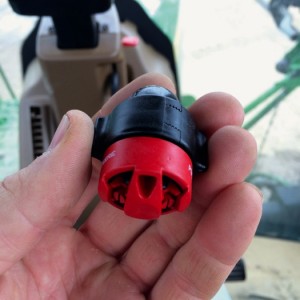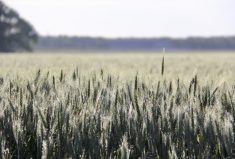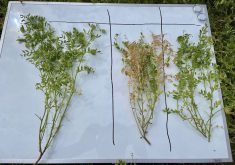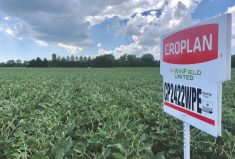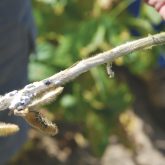Kristjan Hebert knows exactly what his target is when he is spraying fungicide on his wheat. “One hundred per cent,” says the Moosomin, Sask.-area grain grower, who farms with his father. “Our goal is to get it all covered at the heading stage.”
That’s a far cry from just a few years ago, when the biggest question about fungicide use on cereal crops was whether it was even worth doing, especially during an era of lower grain prices.
Read Also

Sensing the soil: Root cell research finds ‘stress hormone’
Research into how root cells react to soil stressors could help plants better adapt to changes in their climate.
But Hebert has the numbers to back up this strategy, having run on-farm trials early in the adoption curve to determine how the economics of fungicide applications on wheat stacked up.
“We always do three years of testing. No numbers or data are as good as the ones you get from your own farm,” Hebert says. “After three years, if the return on investment is always positive, we adopt it whole farm.”
In this case those numbers did add up, and they have continued to show a payback when he has periodically revisited the question over the years. Basically, he says, the numbers have never dipped into the red. So now every wheat crop gets fungicide applications.
“It has always covered at least the cost of the product and the application,” Hebert says.
Lethbridge, Alta.-area farmer Henk Kamper echoes Hebert’s sentiments, saying fungicide applications are an important part of their crop protection strategy, so his family, which farms under the Kamper Enterprises banner, doesn’t waste a lot of time every season wondering if they should fill the sprayer.

While they farm in an area with drier conditions, the Kampers grow under irrigation. This can build disease pressure that might not otherwise exist by creating the perfect conditions for its development.
“For us the question with fungicide applications on our wheat isn’t ‘if,’ but ‘when,’” Kamper says.
Back on the Hebert farm, the fungicide mainly goes down through their ground rig, using double-sided nozzles, a system Hebert says gives the most consistent results. But when the inevitable time crunch hits the 8,000-acre operation, the total coverage target remains most important.
“I’d rather do it with our sprayer, but if time won’t permit that, we have no problem calling in a plane or helicopter,” Hebert says.
Hebert says that while the aerial results aren’t as consistent, any application still has a worthwhile impact on yield and quality. He stresses, however, that aerial application is a last resort and his much preferred option is to go in with a ground rig. He strongly suggests using double-sided nozzles and, if necessary, slowing down a bit to get proper coverage.
“If you’re going to do a pass, get the best coverage you possibly can,” Hebert says.
- More Country Guide: Whether to spray for fusarium: flowering period is key
Kamper says their operation is similar, and they’re likewise dedicated to doing the job right, using a system with three main pillars.
At application time it’s mainly a question of using the right equipment and getting the spray mix right. Kamper says they use between 15 and 20 gallons of water an acre, depending on which fungicide they’re spraying. Less than that will mean incomplete coverage. They also use double-sided nozzles (see below) to ensure coverage on both sides of the heads.
“The right nozzles, the right water volume, the right timing — this is our strategy to get the most out of our fungicide applications,” Kamper says.
Once the application system has been refined, the main challenge is hitting a narrow spray window. And while there’s been some debate over the years about what the best timing is, that’s increasingly become a settled question, according to one industry player.
Every fall, after the harvest at Richardson International’s Kelburn research farm, just south of Winnipeg on the banks of the Red River of the North, Wes Anderson spends a few days pouring over an Excel spreadsheet of the latest data in his ongoing fungicide trials.
Anderson, the company’s agronomy manager, has spent a lot of time over the past few years looking at optimal fungicide timing on wheat crops. He’s currently got about 10 years of solid data from farm trials, as well as anecdotal evidence from the company’s team of agronomists situated throughout Western Canada.
“We did the first of our trials with what are now older products — Tilt and Headline,” Anderson says. “Then we did lots of trials with Folicur, and lately we’ve been using the newest products, like Prosaro. I think we’ve got a lot of good data.”

That data is sending a clear message, Anderson says. Growers looking for the best time to apply fungicides should be targeting the heading stage most years, with earlier applications only in the event of heavy pressure from leaf diseases that could hit the flag leaf and hamper yield.
“Our Kelburn data shows that four years out of five, applications at the T-3 (heading) stage give the best economic results,” Anderson says. Partly that’s because of a mild yield boost, but mainly it’s a question of crop quality, with the heading-stage applications keeping a lid on fusarium-damaged kernels and DON mycotoxins, and therefore preventing downgrading.
A representative of one of the leading fungicide manufacturers agrees this seems to be the consensus that’s emerging.
When Troy Basaraba joined Bayer in 2003, cereal fungicides were still very much in their infancy. Folicur was just emerging and the ongoing debate amongst growers was over whether or not there was a compelling economic case to be made for the applications on wheat.
Now, the question has become what’s the optimal timing for fungicide applications, and Basaraba has been heavily involved in recent years in a Bayer program that runs strip trials throughout Western Canada in commercial fields to compare various fungicide treatments.
“Initially the thinking was you should protect the flag leaf from leaf diseases at all costs,” Basaraba says. “We’ve seen that change over time and evolve to more focus on protection from fusarium head blight. I would say that over the past six years or so, we’ve seen a move from flag-leaf timing to applying it at heading time.”
There are a number of factors that have gone into this evolution, Basaraba says. New products offer multiple modes of action and better protection from fusarium. Other farming practices such as minimum- and zero-till farming systems have changed the environment for the disease, leaving much more crop residue on the field surface where it can act as a host to the disease. Then there’s been the general spread and growth of disease pressure throughout the region, so that even parts of the Prairies such as Alberta where the pressure has been lower are grappling with this new reality.
“They’ve definitely got it there — it’s just less than everywhere else,” Basaraba said.
Basaraba agrees with Anderson, saying timely scouting can help refine the appropriate application timing in season, and that it’s always going to be a balancing act between protecting the flag leaf during times of high pressure from the leaf disease complex, while at the same time grappling with the perennial challenge of fusarium.
- From the Grainews website: Precision matters with fusarium
“Basically it’s Agronomy 101,” Basaraba says. “You need to keep your nose in the crop.”
While Basaraba concedes that every growing season is going to vary, he says the numbers on his spreadsheets don’t lie, and the question of what the best fungicide timing is has become a lot closer to settled in his mind as season after season of data have accumulated.
“I think it’s quite clear that most seasons, you’ll get better yield protection, better response and a better return on investment at heading,” Basaraba says.
Basaraba says typically the portions treated at head timing have about a half a bushel more yield. And even more importantly, they’ve generally got better grain quality.
Back on the farm, both grain growers confirm that they’re mainly shooting for head timing applications these days.
“We apply at head timing with fungicides, and we see that timing as the best,” Kamper says.
It’s not even necessarily a question of yield, although there is likely some yield benefit. For their farm, the key question is quality. That’s what they’re paid for and by spraying just at the time of heading and flowering, they protect quality and prevent damaged kernels and elevated levels of mycotoxins.
Another wrinkle in the operation is that they include both wheat and grain corn in their rotation, providing a second potential host crop for fusarium head blight. But even without the corn issue, the farm and others in the area have to face the simple fact that — like most other parts of the Prairies — fusarium has become a fact of life and the disease is always there, just waiting for the right conditions to flourish in the crop canopy, making hitting it with a fungicide at heading a perennial goal of the farm.
Hitting that head-timing window, however, is easier said than done, because it’s such a narrow one. Just four or five days long, for the typical modern commercial-scale grain grower it makes for a lot of ground to cover, Kamper concedes.
“You can do it if you’re set up for it,” Kamper says. “Keep scouting, and be ready to move as soon as they head out. Be ready for it and go at it as hard as you can.”
Producers can also do a few things earlier in the season to make life a bit easier, such as taking care at seeding time to do a good job to get even germination and emergence so the entire field begins heading at the same time, setting up conditions for a more successful application.
Hebert agrees head timing seems to deliver the best results, although he admits he’d hit it at flag-leaf stage too — if there were only enough days to do the work. As it is, they typically blend a low rate of fungicides and spray them along with weed control products, hoping to keep the leaf diseases in check until the head-timing applications.
“This means we’re typically applying our weed control products a bit toward the later end of the application range,” Hebert says.
It’s all just part of the farm’s central philosophy, which assumes every crop that goes into the ground has a 100 per cent chance of remaining healthy and hitting its full yield potential.
“We do everything we can to manage the evironment and fertility to protect that 100 per cent potential,” Hebert says.
“It really is a bit of a balancing act,” Anderson agrees. “It all comes down to how bad the leaf disease pressure is earlier in the season, and if it gets really bad, you can’t always wait for heading.”
In recent years, fusarium head blight has become endemic in Western Canada. Unlike leaf diseases, which frequently have to be blown in from farther south, this disease winters here. It’s always laying in wait, ready for the next time weather conditions line up for a full-blown epidemic. That makes it the more important of the diseases to manage proactively, and the more likely candidate to deliver a bigger bang for the buck and effort.
One thing that has become apparent in recent years is that farmers are taking cereals management much more seriously than they used to. They’re optimizing their fertility and weed control packages, and they have increased their use of fungicides and are paying more attention to application timing as part of that trend.
“We’ve come a long way with wheat,” Anderson says. “These crops are much more intensively managed than they used to be just five or 10 years ago.”
Another area where there have been improvements is in the available fungicides, such as Prosaro, one of the latest offerings. Initially Anderson says he wasn’t expecting much beyond a little modest evolution in efficacy, but instead he’s finding it’s delivering a bit more than expected.
“We’re finding it (Prosaro) is delivering longer and better protection,” Anderson says.
Bayer’s Troy Basaraba agrees the exception to that rule is when there’s “massive” leaf disease pressure, something like rust spores blowing in from down south during a spring with good conditions for the disease’s development.
Under those conditions, Basaraba agrees with Anderson that earlier applications can have a positive return on investment too.



